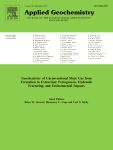Hasenmueller et al., 2015
Topographic controls on the depth distribution of soil CO2 in a small temperate watershed
Hasenmueller, E.A., Jin, L., Stinchcomb, G.E., Lin, H., Brantley, S.L., Kaye, J.P. (2015)
Applied Geochemistry, vol 63, 58-69
-
Shale Hills, INVESTIGATOR, COLLABORATOR
-
Shale Hills, INVESTIGATOR, COLLABORATOR
-
IML, Shale Hills, INVESTIGATOR
-
National, Eel, Luquillo, Shale Hills, INVESTIGATOR, COLLABORATOR
-
Shale Hills, INVESTIGATOR
Abstract
Accurate measurements of soil CO2 concentrations (pCO2) are important for understanding carbonic acid reaction pathways for continental weathering and the global carbon (C) cycle. While there have been many studies of soil pCO2, most sample or model only one, or at most a few, landscape positions and therefore do not account for complex topography. Here, we test the hypothesis that soil pCO2 distribution can predictably vary with topographic position. We measured soil pCO2 at the Susquehanna Shale Hills Critical Zone Observatory (SSHCZO), Pennsylvania, where controls on soil pCO2 (e.g., depth, texture, porosity, and moisture) vary from ridge tops down to the valley floor, between planar slopes and slopes with convergent flow (i.e., swales), and between north and south-facing aspects. We quantified pCO2 generally at 0.1–0.2 m depth intervals down to bedrock from 2008 to 2010 and in 2013. Of the variables tested, topographic position along catenas was the best predictor of soil pCO2 because it controls soil depth, texture, porosity, and moisture, which govern soil CO2 diffusive fluxes. The highest pCO2 values were observed in the valley floor and swales where soils are deep (≥0.7 m) and wet, resulting in low CO2 diffusion through soil profiles. In contrast, the ridge top and planar slope soils have lower pCO2 because they are shallower (≤0.6 m) and drier, resulting in high CO2 diffusion through soil profiles. Aspect was a minor predictor of soil pCO2: the north (i.e., south-facing) swale generally had lower soil moisture content and pCO2 than its south (i.e., north-facing) counterpart. Seasonally, we observed that while the timing of peak soil pCO2 was similar across the watershed, the amplitude of the pCO2 peak was higher in the deep soils due to more variable moisture content. The high pCO2 observed in the deeper, wetter topographic positions could lower soil porewater pH by up to 1 pH unit compared to porewaters equilibrated with atmospheric CO2 alone. CO2 is generally the dominant acid driving weathering in soils: based on our observations, models of chemical weathering and CO2 dynamics would be improved by including landscape controls on soil pCO2.
Citation
Hasenmueller, E.A., Jin, L., Stinchcomb, G.E., Lin, H., Brantley, S.L., Kaye, J.P. (2015): Topographic controls on the depth distribution of soil CO2 in a small temperate watershed. Applied Geochemistry, vol 63, 58-69. DOI: 10.1016/j.apgeochem.2015.07.005
 This Paper/Book acknowledges NSF CZO grant support.
This Paper/Book acknowledges NSF CZO grant support.
Explore Further






